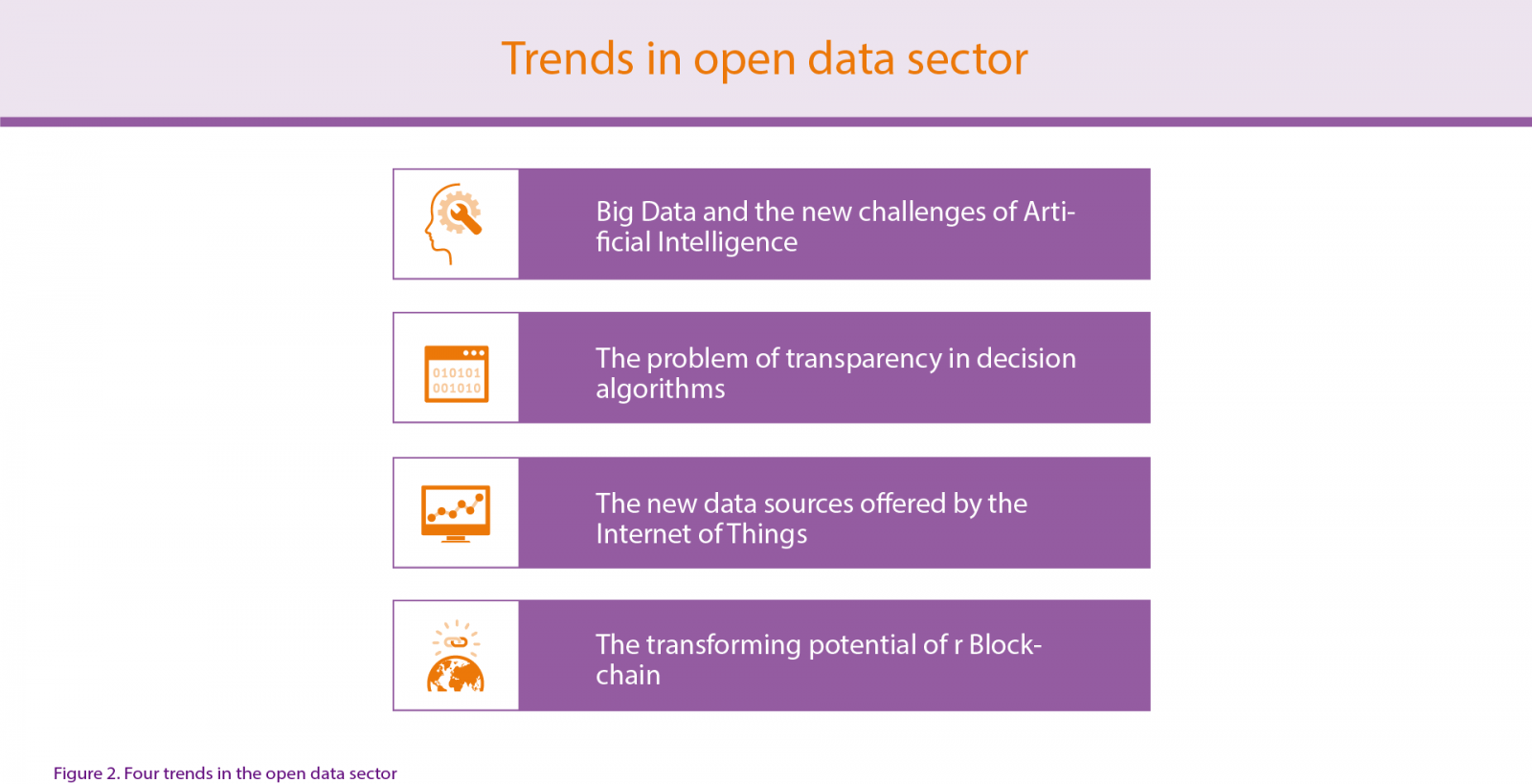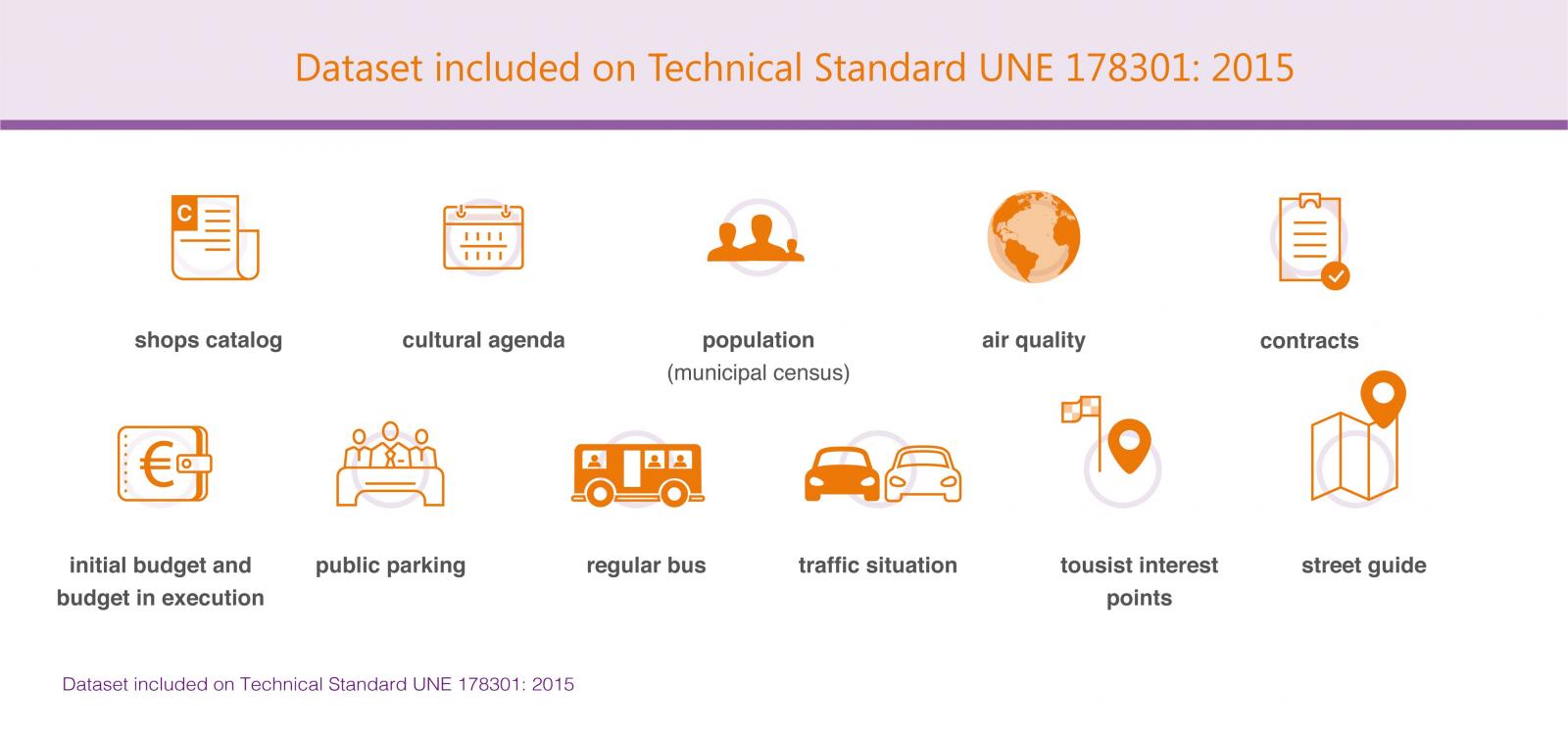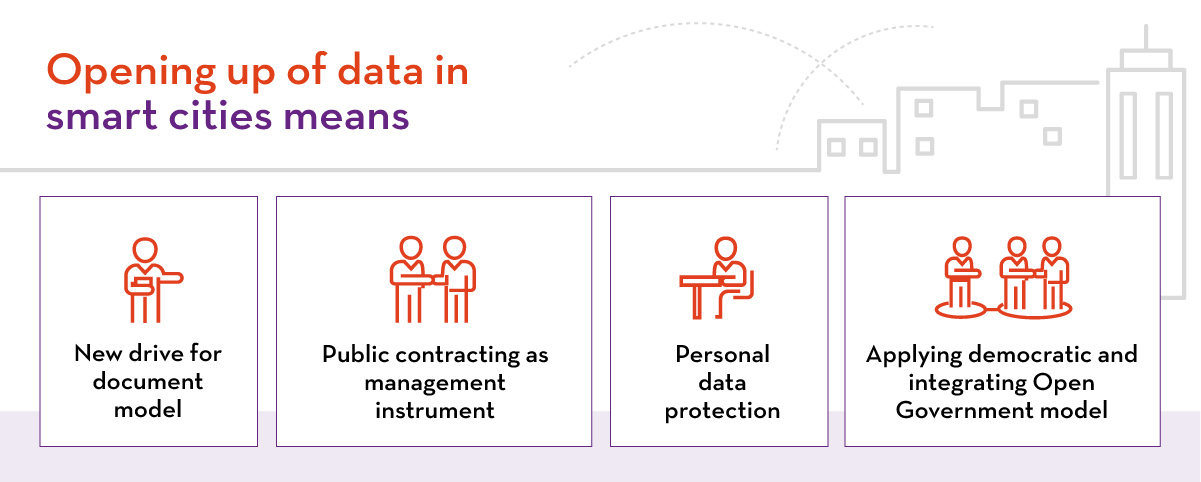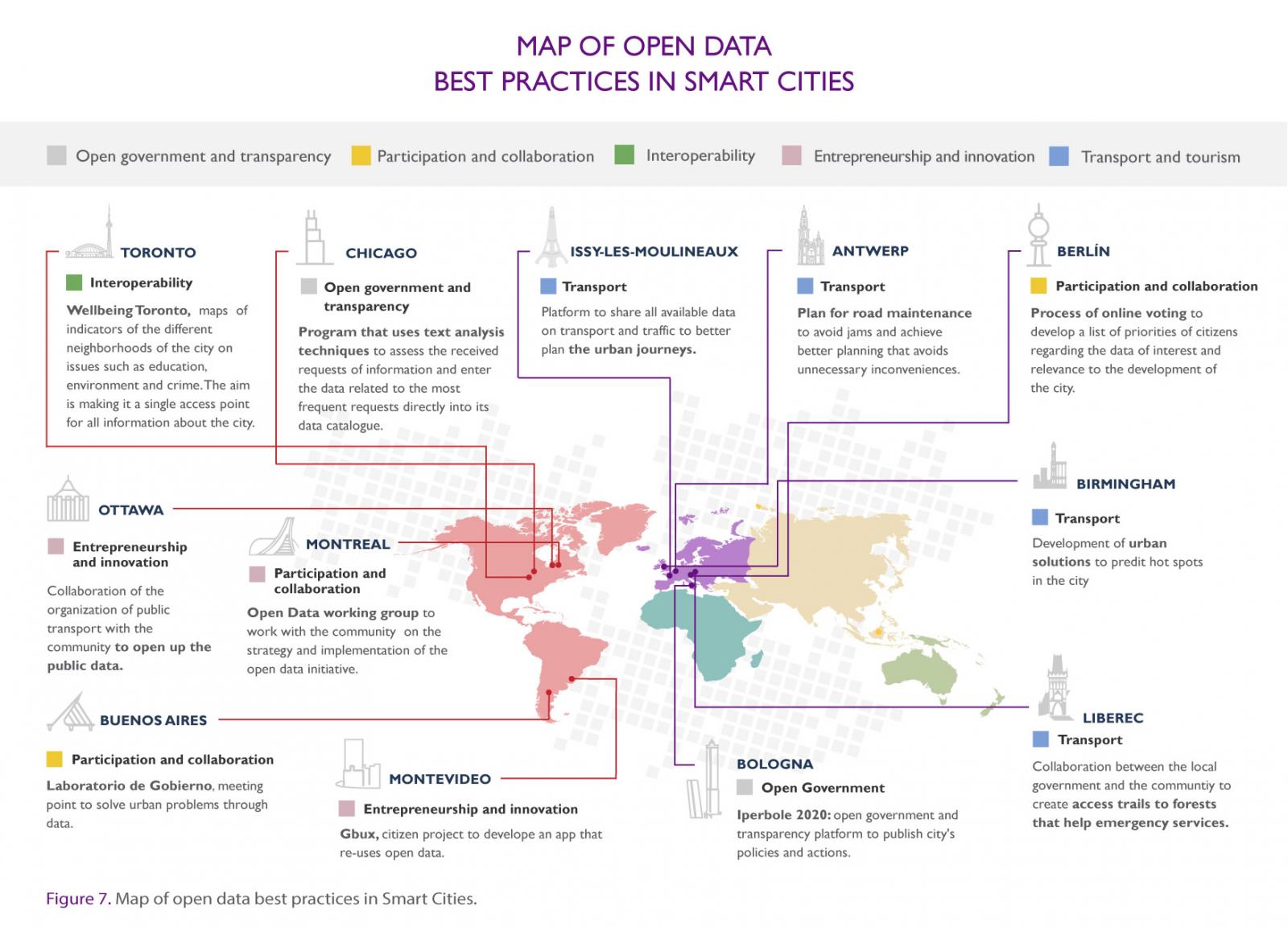In the digital world, data becomes a fundamental asset for companies. Thanks to them, they can better understand their environment, business and competition, and make convenient decisions at the right time.
In this context, it is not surprising that an increasing number of companies are looking for professional profiles with advanced digital capabilities. Workers who are able to search, find, process and communicate exciting stories based on data.
The report "How to generate value from data: formats, techniques and tools to analyse open data" aims to guide those professionals who wish to improve the digital skills highlighted above. It explores different techniques for the extraction and descriptive analysis of the data contained in the open data repositories.
The document is structured as follows:
- Data formats. Explanation of the most common data formats that can be found in an open data repository, paying special attention to csv and json.
- Mechanisms for data sharing through the Web. Collection of practical examples that illustrate how to extract data of interest from some of the most popular Internet repositories.
- Main licenses. The factors to be considered when working with different types of licenses are explained, guiding the reader towards their identification and recognition.
- Tools and technologies for data analysis. This section becomes slightly more technical. It shows different examples of extracting useful information from open data repositories, making use of some short code fragments in different programming languages.
- Conclusions. A technological vision of the future is offered, with an eye on the youngest professionals, who will be the workforce of the future.
The report is aimed at a general non-specialist public, although those readers familiar with data treatment and sharing o in the web world will find a familiar and recognizable reading.
Next, you can then download the full text, as well as the executive summary and a presentation.
Note: The published code is intended as a guide for the reader, but may require external dependencies or specific settings for each user who wishes to run it.
Blockchain is one of the most popular buzzwords. Every day, several news tell us how blockchain will revolutionize all sectors, from banking to manufacturing, journalism or health. The public sector is also affected by this trend and public organizations are gradually implementing this technology, linked to open data initiatives, to guarantee data quality. However, there are still many doubts about what blockchain is.
Blockchain was born as a technological base for the correct functioning of digital currencies - bitcoin - payments. It is a set of technologies that facilitate the decentralized exchange of digital information, eliminating the need for intermediaries. Each transaction is organised into interconnected blocks, in such a way that any change in one link affects the previous one. In this way, the network participants can detect any fraud attempt in real time.
To shed some light on this technology, we have developed the White Paper Discovering blockchain keys, aimed at those people who want to understand its functioning. Through various examples, the document analyzes how a blockschain is configured, explaining in a simple way different concepts such as Hash - that is, the unique fingerprint of each transaction - or nonce – a random number that generates the hash.
The White Paper also address some of the main use cases of blockchain, as well as their benefits and challenges. According to the report, blockchain facilitates transactions in a more transparent and efficient way – automated, without human intervention -, and it is safe and fast, among other advantages. On the contrary, some of the challenges faced by organizations that want to start using blockchain are the lack of qualified talent, the need to improve citizens' electronic security practices, the regulatory changes or the resistance to change.
The document concludes with a hopeful message for the sector: the blockchain market is expected to experience a notable growth during the next 4 years, reaching a Compound Annual Growth Rate (CAGR 2017-2022) of 71.46%.
The amount of data we generate does not stop growing. 90% of the data created in the history of humanity were produced during the last year and a 40% annual growth is estimated for the next decade. These figures highlight the importance of data in today's economy and society. The data provide us with knowledge, which facilitate to make the right decisions at the right time.
To optimize the advantages that the use of data can bring to our day to day, an increasing number of organizations and companies are implementing new technologies that help to improve their management and obtain greater value. The report New trends and challenges in the data world analyzes some of these technological and social trends that are revolutionizing the world of data. These technologies are big data and artificial intelligence, decision algorithms, internet of things and blockchain.

The following are some of the main conclusions of the report:
Big Data and Artificial Intelligence
- What is it? The analysis of large volumes of data, from different sources and with different formats, in real time, acquires a new dimension combined with artificial intelligence technologies, which apply reason guidelines to data.
- What are its advantages? Thanks to these technologies, companies and organizations can better understand the current and future functioning of their environment, and face the challenges at the right time. The combination of Artificial Intelligence and Big Data can boost economic growth, respond to citizens needs and optimize public services. In addition, it can contribute to the strengthening of democracy.
- What are its challenges? The lack of talent with the necessary skills, the limitation in current infrastructures and the privacy protection are the main challenges that organizations have to face when implementing a Big Data initiative.
The decision algorithms
- What is it? These are automated agents capable of extracting value from a large volume of data in an agile and efficient way, facilitating automatic decision making.
- What are its advantages? Decision algorithms allow more efficient, transparent and equitable decision making.
- What are its challenges? Among the challenges faced by people in charge of algorithms management is ensuring the quality and availability of data through controls and audits, as well as ensuring their integrity, ethics and independence.
Internet of Things
- What is it? When we talk about Internet of Things (IoT) we refer to a network of connected objects, by wireless or cable, capable of generating data without human intervention.
- What are its advantages? IoT facilitates processes automation and provides new and multiple forms of interaction that contribute to improving universality and accessibility to services.
- What are its challenges? The main inhibitors of IoT are security and privacy, interoperability and the need for new infrastructures. It is also important to bear in mind that IoT can contribute to increasing the existing gap between different social classes according to their possibilities of data and services access.
Blockchain
- What is it? Blockchain is a distributed database that controls the transfer of digital information. That is, a kind of account book where the records are encrypted and interleaved, so change in one of the blocks affects the others.
- What are its advantages? Its main advantage is the security and privacy of information, the integrity, the sustainability, the transparency and the (quasi) anonymity. This will allow us to transform our political system and enable profound social changes.
- What are its challenges?
- The lack of qualified talent, the regulatory changes, the electronic security of citizens and the limits on institutions ability to adapt the new enviroment are the main challenges highlighted in the report.
Thanks to Big Data and artificial intelligence, decision algorithms, Internet of Things or Blockchain, organizations and companies can extract the necessary value from the data, which will help them to improve services and products for citizens. Although these four technologies are still in a phase of incipient adoption, they are expected to grow rapidly over the next few years, once the above-mentioned challenges are overcome - if you want to delve into these challenges you can read the report New trends and challenges in the world of data.
.dge-detail__img{display:none;}
As a result of transparency and citizen participation demand, an increasing number of towns are focus on initiatives that facilitate citizen access to institutions and administrations´ information. However, defining, implementing and documenting an open data policy could be a challenging issue. Some of the most frequently asked questions by agents involved in these initiatives are:
-
Which data are more strategic and which fundamental aspect should be consider at publishing?
-
How could I facilitate datasets integration from different sources?
-
What is the regulatory framework?
In this context, AENOR elaborated the Technical Standard UNE 178301: 2015. It provides a series of recommendations to standardize open data publication and improve data management. This Technical Standard includes a list of 11 datasets considered a priority by AENOR: shops catalog, cultural agenda, population (municipal census), air quality, contracts, initial budget and budget in execution, public parking, regular bus, traffic situation, tourist interest points and street guide.

In addition, Technical Standard UNE 178301: 2015 includes recommended vocabulary to optimize data publication, framed within Linked Data paradigm (a set of best practices, articulated through W3C standard technologies). The objective is to facilitate the development of a data website where different elements can be linked, simplifying navigation and data location, within a common international framework.
The report "Open data representation vocabulary in Digital Cities" provides an analysis of this Technical Standard. It include the description of each dataset, potential use cases and legislative framework- when applicable–, and common publication formats. In addition, the report includes an assessment of AENOR´s semantic proposal adequacy and development degree.
The commitment to so-called smart cities is currently one of the major commitments to technological innovation in the public sector, especially in the local sphere. This type of initiative aims to address challenges to sustainability in the urban context and, through the advanced use of information and communication technologies, to optimise resources and make public services more efficient.
The report ‘Open Data and Smart Cities: an alternative legal perspective’ that we published on Datos.gob.es approaches the scope and legal analysis of data openness in this type of project. It is particularly important to provide legal security for the investments and efforts being made by both local governments and service providers and, in general, for the involvement of civil society in this field. As analysed in this report, the plurality of actors and services involved determines the diversity of legal standards in a context where information and communication technologies require interoperability.

Structured into five chapters, the report deals with Law as a tool to serve smart cities, the diversity of actors as a subjective element, the plurality of services involved in a technological context as an objective element, and the scope of the regulatory framework applicable to intelligent cities from the perspective of open data. This last section details the regulations on electronic Government, the legal provisions on transparency and access to public sector information, the legal provisions on the re-use of public sector information, and the legislation covering the protection of personal data.
In the fifth and final chapter, which focuses on the prominence of legal means, the report raises the need for paradigm shifts to drive open data in smart city projects. In particular, it advocates the promotion of a management model based on the foundation of Open Government at the municipal government level, using its legal powers and means. It also proposes a series of prerequisites required to allow the opening of data in smart cities in order to facilitate the re-use of the data generated.
In conclusion, the report ‘Open Data and Smart Cities: an alternative legal perspective’ refers to the need to be aware of the fragmentation of the existing regulatory framework and the challenge for local governments when making reasonable modifications to their own regulations and supporting effective leadership in order to offer value-added services based on their re-use according to the principles of open data.
The attached Report can be downloaded in PDF, Word, and ODT format.
Esta unidad recoge las definiciones de los principales conceptos básicos que permiten comprender los datos abiertos, aclarar y reforzar las bases para poder ampliar conocimiento. Se enumeran los beneficios que aporta la apertura de los datos y se hace un recorrido por las principales barreras y retos a los que hacer frente al iniciar un proceso de apertura de datos.
Objetivos:
- Diferenciar conceptos básicos relacionados con los datos abiertos tomando como referencia el marco legislativo vigente en España.
- Reconocer los principios generales a tener en cuenta para asegurar que los datos abiertos son fácilmente reutilizables.
- Descubrir los principales beneficios económicos y sociales que supone la apertura de datos públicos.
- Conocer los aspectos clave ligados al ecosistema de los datos de cara a asegurar la generación de los beneficios apuntados.
- Identificar las principales barreras actualmente existentes y, en consecuencia, los retos a los que se ha de hacer frente.
Unidad didáctica:
Material complementario:
- Vídeos de ayuda para reutilizadores de datos en datos.gob.es
- Las administraciones públicas ante la reutilización de la información pública
- La importancia de la gestión de los datos maestros
- Crónica de la 12ª Conferencia Internacional de Reutilización de Información del Sector Público
- La ONU proporciona una serie de directrices para impulsar los datos estadísticos en abierto
- Use Case Observatory, una iniciativa del Portal Europeo de Datos Abiertos para medir el impacto del open data
- Pelando la cebolla de la gobernanza de los datos abiertos
- ¿Cuáles son los principales elementos de un espacio de datos?
- Los datos abiertos como bienes digitales públicos
- Inteligencia artificial y datos abiertos
- Explorando el papel de los datos abiertos en la web3
- Radiografía del dataspace nacional de Turismo: retos y oportunidades para el sector turístico
- Conceptos básicos, beneficios del Open Data y barreras para su aplicación
- Data.europa.eu y los espacios comunes de datos europeos: un informe sobre retos y oportunidades
- Datos en tiempo real: Enfoques para integrar fuentes de datos en tiempo real en data.europa.eu
Puedes acceder al resto de material complementario mediante el siguiente enlace.
Cities are increasingly gaining population. While large cities only occupy around 2% of the planet's land mass, nowadays half of humanity lives in cities, 70% of the population in Europe, and it is expected that by the year 2030, almost 60% of the world population will live in urban areas consuming approximately 80% of the planet's resources.
Demographic growth will be a major challenge in the sustainable and efficient management of cities.Transport, education, health care, waste management ... are just some of the areas that will be affected and may become an obstacle on the way to the Smart Cities. In this global context, data is an essential resource and its openness and reuse are key aspects to understand what is happening in cities and make the right decisions to ensure the optimal management of Smart Cities.
Aware of the potential of Open Data, Iniciativa Aporta has published a new version of its report "Open Data, as a tool for Smart Cities". A document that addresses both the strategic aspects of Open Data for a local administration and the necessary components for the success of an initiative of this nature, all exemplified by real cases of different cities in the world. In this way, the reader can locate in the globe the most significant international initiatives that re-use information of the public sector to improve the quality of life of citizens.

In order to improve and update this material, the content has been enriched with graphic elements that help its comprehension and dissemination. In addition, a map has been included where the world's most relevant Open Data and Smart Cities projects are located according to five priority themes: transport, tourism, open government, interoperability and entrepreneurship.
All the materials created to date are available in the Documentation section of the new portal datos.gob.es, where not only the documents are published but the user has also the opportunity to find resources from other organisms, all related to the re-use of public sector information.
There is increasingly more information, to such extent that the current society lives surrounded by data. Nevertheless, one of the most common criticisms of this mass of information is its lack of usability. It is not only a matter of publishing data on the web, but we should focus on their treatment, re-use and consumption by the end user. Only when we approach them and apply an interpretation they make sense and become knowledge.
In this technological context, data exploitation has evolved in the last decades to design interpretation mechanisms that are increasingly robust and affordable. And among these exploitation mechanisms, the most important is data visualization.
In this framework, Iniciativa Aporta has elaborated the report “Data visualization: definition, technologies and tools”, a handbook based on the analysis on two distinct but complementary aspects. On one hand, the visualization technologies are explained in detail as frameworks and coding libraries that allow the construction of applications and data based services; including exclusively the cutting-edge web technology and especially that which is built on standards, such as HTML5 (Canvas), SVG and WebGL.
On the other hand, this documents takes a journey through the available visualization platforms, analysing the applications that allow the construction of dashboards and comprehensive interactive visualizations. Those platforms that are more web-oriented and can be applied to the exploitation of open data, those coming from the world of BI and data analysis, are presented in detail: Tableau Soft, Qlik and Tabulae. Or, failing this, open data publishing tools that incorporate certain features of visualization: CKAN and Socrata.
Currently the number of tools and platforms for data visualization that can be accessed is very extensive. Thus, this report includes together with these instruments a set of real examples, some of them more closely linked to the data analysis and visualizations, whereas others provide support to data publication, which add to their functionality capabilities of graphic representation of data for their consumption.
In order to help in the treatment of such information and transformation into more readable formats, the report includes seven examples of data visualizations, from public sector and independent entities both national and international. It concludes analysing future trends on data treatment: Visualization and large volumes of data, visualizations that can be built by the end user and the development of 3D visualization technologies.
Nowadays, visualization is a powerful tool to discover and understand the logic behind a dataset, open or not, and to share this interpretation with others from an objective point of view. For this reason, this report is an opportunity to show to stakeholders of the national open data community the way to treat and transform the raw material into a useful resource for any purpose.
The Spanish Data Protection Agency (AEPD) has launched a guide to promote the re-use of public sector information whereas the privacy of citizens is guaranteed. In order to provide some guidelines that help the implementation of these techniques, the AEPD has also published the document entitled “Guidelines and guarantees in the process of personal data anonymisation” which explains in detail how to hide, mask or dissociate personal data in order to eliminate or minimize the risks of re-identification of anonymised data, enabling the release and guaranteeing the rights to data protection of individuals or organizations that do not wish to be identified, or have established the anonymity as a condition to transfer their data for publication. In other words, a formula to juggle the promotion of the re-use with the regulatory rules on data protection, which ensures that the effort in re-identification of individuals carries a cost high enough to not be addressed "in terms of relative effort -benefit".
The document shows both the principles to be considered in a process of anonymization in the design stages of the information system (principle of privacy by default, objective privacy, of full functionality, etc.), as the phases of the performance protocol in the process of anonymisation, including the following:
- Defining the team detailing the functions of each profile, and ensuring, as far as possible, that each member performs the tasks independently of the rest. Thus, it prevents that an error in a level is reviewed and approved at a different level by the same agent.
- Risk analysis to manage risks arising from the principle that any anonymisation technique can guarantee absolutely the impossibility of re-identification.
- Defining goals and objectives of the anonymised information.
- Preanonymisation, elimination/reduction of variables and cryptographic anonymisation through techniques such as hashing algorithms, encryption algorithms, time stamp, and anonymisation layers, etc.
- Creating a map of information systems to ensure segregated environments for each processing of personal data involving the separation of personnel accessing such information.
Finally, the document highlights the importance of training and informing the personnel involved in the processes of anonymization who work with anonymised data, focussing on the need of establishing guarantees to protect the rights of stakeholders (confidentiality agreements, audits of the use of anonymised information by the recipient ...) and establishes as a fundamental conducting regular audits of anonymization policies, which must be documented.

The AEPD offers these guidelines even knowing that the same technological capabilities that are used to anonymise personal data can be used for re-identification of people. That is the reason to emphasize the importance of considering the risk as a latent contingency and sustain the strength of the anonymisation in impact assessment measures, organizational, technological, etc. .; all in order to combine the provision of public data and ensure the protection of personal data in the re-use of information with social, scientific and economic purposes.